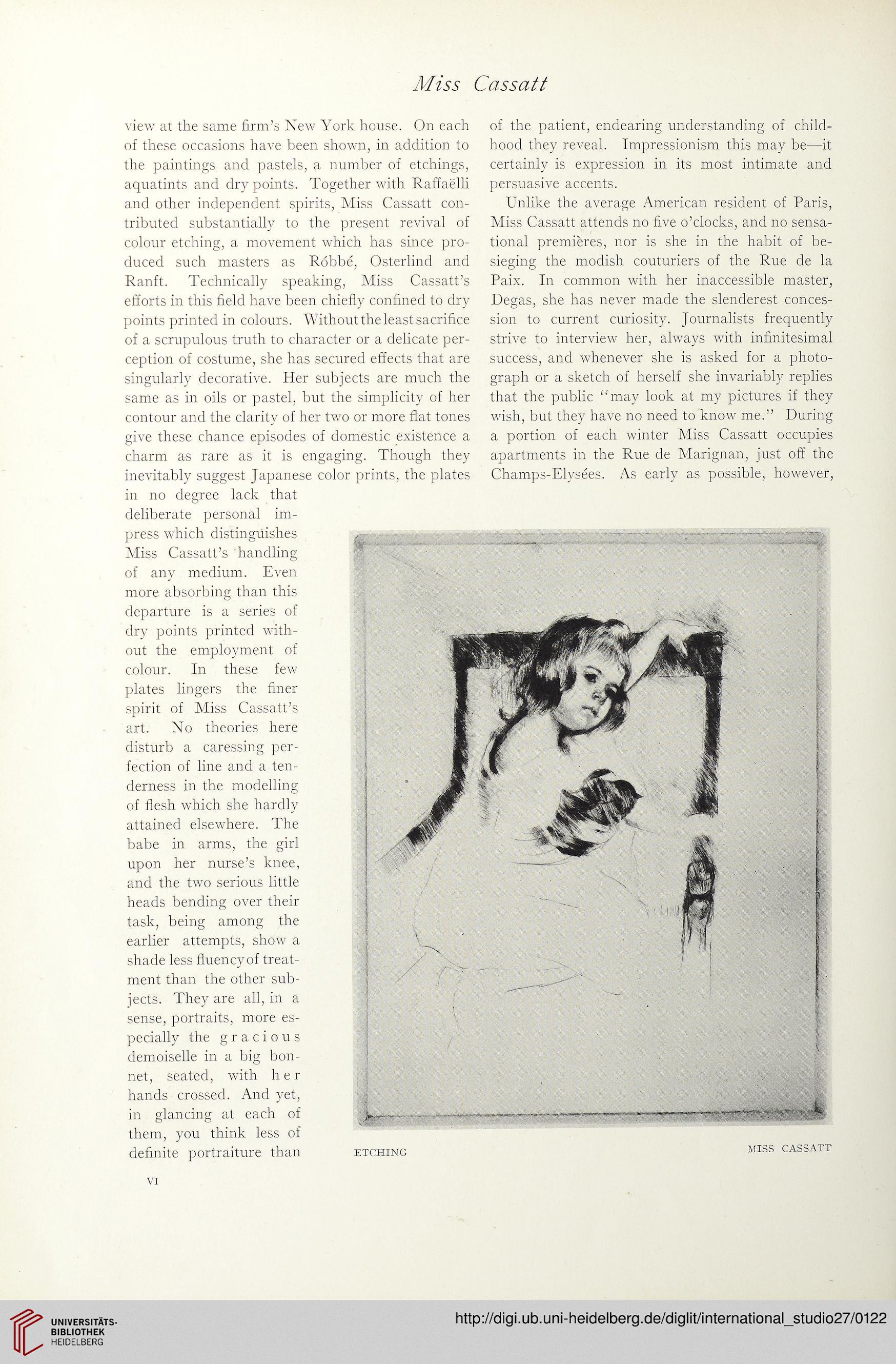Miss Cassatt
view at the same firm’s New York house. On each
of these occasions have been shown, in addition to
the paintings and pastels, a number of etchings,
aquatints and dry points. Together with Raffaelli
and other independent spirits, Miss Cassatt con-
tributed substantially to the present revival of
colour etching, a movement which has since pro-
duced such masters as Robbe, Osterlind and
Ranft. Technically speaking, Miss Cassatt’s
efforts in this field have been chiefly confined to dry
points printed in colours. Without the least sacrifice
of a scrupulous truth to character or a delicate per-
ception of costume, she has secured effects that are
singularly decorative. Her subjects are much the
same as in oils or pastel, but the simplicity of her
contour and the clarity of her two or more flat tones
give these chance episodes of domestic existence a
charm as rare as it is engaging. Though they
inevitably suggest Japanese color prints, the plates
in no degree lack that
deliberate personal im-
press which distingüishes
Miss Cassatt’s handling
of any medium. Even
more absorbing than this
departure is a series of
dry points printed with-
out the employment of
colour. In these few
plates lingers the finer
spirit of Miss Cassatt’s
art. No theories here
disturb a caressing per-
fection of line and a ten-
derness in the modelling
of flesh which she hardly
attained elsewhere. The
babe in arms, the girl
upon her nurse’s knee,
and the two serious little
heads bending over their
task, being among the
earlier attempts, show a
shade less fluencyof treat-
ment than the other sub-
jects. They are all, in a
sense, portraits, more es-
pecially the gracious
demoiselle in a big bon-
net, seated, with her
hands crossed. And yet,
in glancing at each of
them, you think less of
definite portraiture than
of the patient, endearing understanding of child-
hood they reveal. Impressionism this may be—it
certainly is expression in its most intimate and
persuasive accents.
Unlike the average American resident of Paris,
Miss Cassatt attends no five o’clocks, and no sensa-
tional premieres, nor is she in the habit of be-
sieging the modish Couturiers of the Rue de la
Paix. In common with her inaccessible master,
Degas, she has never made the slenderest conces-
sion to current curiosity. Journalists frequently
strive to interview her, always with infinitesimal
success, and whenever she is asked for a photo-
graph or a sketch of herseif she invariably replies
that the public “may look at my pictures if they
wish, but they have no need to know me.” Düring
a portion of each winter Miss Cassatt occupies
apartments in the Rue de Marignan, just off the
Champs-Elysees. As early as possible, however,
ETCHING MISS CASSATT
VI
view at the same firm’s New York house. On each
of these occasions have been shown, in addition to
the paintings and pastels, a number of etchings,
aquatints and dry points. Together with Raffaelli
and other independent spirits, Miss Cassatt con-
tributed substantially to the present revival of
colour etching, a movement which has since pro-
duced such masters as Robbe, Osterlind and
Ranft. Technically speaking, Miss Cassatt’s
efforts in this field have been chiefly confined to dry
points printed in colours. Without the least sacrifice
of a scrupulous truth to character or a delicate per-
ception of costume, she has secured effects that are
singularly decorative. Her subjects are much the
same as in oils or pastel, but the simplicity of her
contour and the clarity of her two or more flat tones
give these chance episodes of domestic existence a
charm as rare as it is engaging. Though they
inevitably suggest Japanese color prints, the plates
in no degree lack that
deliberate personal im-
press which distingüishes
Miss Cassatt’s handling
of any medium. Even
more absorbing than this
departure is a series of
dry points printed with-
out the employment of
colour. In these few
plates lingers the finer
spirit of Miss Cassatt’s
art. No theories here
disturb a caressing per-
fection of line and a ten-
derness in the modelling
of flesh which she hardly
attained elsewhere. The
babe in arms, the girl
upon her nurse’s knee,
and the two serious little
heads bending over their
task, being among the
earlier attempts, show a
shade less fluencyof treat-
ment than the other sub-
jects. They are all, in a
sense, portraits, more es-
pecially the gracious
demoiselle in a big bon-
net, seated, with her
hands crossed. And yet,
in glancing at each of
them, you think less of
definite portraiture than
of the patient, endearing understanding of child-
hood they reveal. Impressionism this may be—it
certainly is expression in its most intimate and
persuasive accents.
Unlike the average American resident of Paris,
Miss Cassatt attends no five o’clocks, and no sensa-
tional premieres, nor is she in the habit of be-
sieging the modish Couturiers of the Rue de la
Paix. In common with her inaccessible master,
Degas, she has never made the slenderest conces-
sion to current curiosity. Journalists frequently
strive to interview her, always with infinitesimal
success, and whenever she is asked for a photo-
graph or a sketch of herseif she invariably replies
that the public “may look at my pictures if they
wish, but they have no need to know me.” Düring
a portion of each winter Miss Cassatt occupies
apartments in the Rue de Marignan, just off the
Champs-Elysees. As early as possible, however,
ETCHING MISS CASSATT
VI





